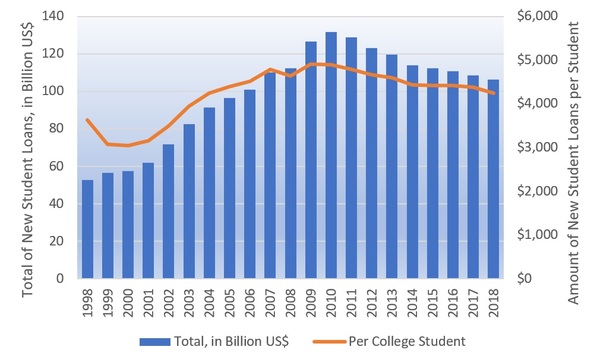
–>
August 27, 2022
The cancellation of student debt has echoes of two other unwise political decisions, one made by a Republican President, the other by a Democrat President.
‘); googletag.cmd.push(function () { googletag.display(‘div-gpt-ad-1609268089992-0’); }); }
In 1987 Ronald Reagan agreed to an amnesty for illegal immigrants. At the time it was a deal that would see current illegal migrants given amnesty in exchange for more border security. The border security was never delivered but the amnesty part was, naturally. There were as many as 11 million illegal migrants in the U.S. at the time of the amnesty, and at least three million were legalized under the exact terms of the amnesty. This amnesty did nothing but incentivize further illegal immigration. The precedent had now been set that the U.S. was in the habit of forgiving illegal immigration. All you had to do was sneak into the U.S., sit tight, and wait for the next amnesty.
The second one was the decision of the Clinton administration to allow people to have access to mortgages they had little chance of actually repaying. Under Clinton’s Housing and Urban Development Secretary, Andrew Cuomo, Community Reinvestment Act regulators gave banks higher ratings for home loans made in “credit-deprived” areas. In short people with low and poor credit were still given massive loans for homes, despite the obvious risk to both borrowers and lenders. The government made clear that it would take the hit for any mortgage default. As a result, banks realized that the smart money was not in being careful with mortgages, but instead lay in getting as many people signed up as possible. After all, Uncle Sam would bail you out. This caused the 2008 economic collapse.
Both examples are useful when considering the announcement this week to cancel student debt. The decision is comparable to the illegal immigration amnesty, as it states all you have to do is take out a student loan and sit tight for the government to cancel the debt for you. Much like the illegal migrants waiting for the next amnesty, there will now be waves of people signing up for student loans and college courses, confident the government will bail them out in the next round of amnesty/debt forgiveness. This is how the current situation is comparable to the amnesty act and mostly impacts the prospective students. But it is not just the students who will be implicated.
‘); googletag.cmd.push(function () { googletag.display(‘div-gpt-ad-1609270365559-0’); }); }
The announcement to cancel debt is comparable to the mortgage schemes of Clinton, as it will change the behavior of the colleges. They had to be slightly careful in terms of college tuition fees, as they needed to make sure their prospective students could actually get a loan. Now that the government has announced student debts will be cancelled, the colleges will be incentivized to increase their fees. After all, now the government will come to the rescue of students who owe the college. Much like the banks being confident that the government would bail them out over mortgages to credit-risky customers, colleges are confident that the government will bail them out for the costs of tuition racked up by students. So why not rack the fees up some more?
 It comes at a time many colleges have seen declines in enrollment. There is a perception that college degrees no longer confer a job market advantage. In 2008 the ratio of STEM to humanities majors was essentially equal. However, between 2009-16, enrolment on humanities degrees programs decreased by 0.4% while STEM degree enrolment surged by 43% in the same period. In ultra-liberal California, the number of STEM undergraduates went up by 39% while humanities degrees declined by 3%. This net difference of 42% in the nation’s most liberal state is quite a development. In New York, the nation’s second largest source of graduates, the number of STEM graduates increased by 45% while humanities managed a meagre 1% increase.
It comes at a time many colleges have seen declines in enrollment. There is a perception that college degrees no longer confer a job market advantage. In 2008 the ratio of STEM to humanities majors was essentially equal. However, between 2009-16, enrolment on humanities degrees programs decreased by 0.4% while STEM degree enrolment surged by 43% in the same period. In ultra-liberal California, the number of STEM undergraduates went up by 39% while humanities degrees declined by 3%. This net difference of 42% in the nation’s most liberal state is quite a development. In New York, the nation’s second largest source of graduates, the number of STEM graduates increased by 45% while humanities managed a meagre 1% increase.
This is interesting, as STEM majors tend to be more conservative than liberal arts majors. This is particularly true for disciplines like engineering. The Democrats are (probably) as aware of these statistics and trends as Arithmos Analytics, and it should worry them. The STEM curriculum is more resistant to woke themes being worked in the curriculum than liberal arts. English Literature majors can be forced to read feminist poetry, but it is difficult to work feminism into advanced calculus or string theory. If the colleges cease to produce reliably liberal graduates and instead produce young people who are (gasp) not indoctrinated or lean conservative (double gasp) then the colleges cease to be useful to the left.
Hence the announcement from the Biden White House this week. While there were elements of appealing to the youth vote, there was also a long-term view. Colleges have been reliably churning out woke foot soldiers who while unemployable, are still good at hash tagging, marching and door knocking for the Democrats. As fewer young people went to college this would narrow the recruiting pool. What better way than to widen things up again by telling students “We will pay your loans off!” and telling colleges “Charge as much as you like, we will cover it!” and thus keep a liberal recruiting ground alive.
The losers will be the American taxpayer. They will now have to pay off the loans of unemployable liberals at the inflated prices set by liberal colleges. Given that as things stand there is already $1.75 trillion in student debt, how much worse will it get after Biden’s announcement? One thing is for sure is that we will all pay for it, in more ways than one.
M J McManus is the Head of Arithmos Analytics. He tweets at @arithmosdata
‘); googletag.cmd.push(function () { googletag.display(‘div-gpt-ad-1609268078422-0’); }); } if (publir_show_ads) { document.write(“
Image Stilfehler
<!– if(page_width_onload <= 479) { document.write("
“); googletag.cmd.push(function() { googletag.display(‘div-gpt-ad-1345489840937-4’); }); } –> If you experience technical problems, please write to [email protected]
FOLLOW US ON
<!–
–>
<!– _qoptions={ qacct:”p-9bKF-NgTuSFM6″ }; ![]() –> <!—-> <!– var addthis_share = { email_template: “new_template” } –>
–> <!—-> <!– var addthis_share = { email_template: “new_template” } –>





